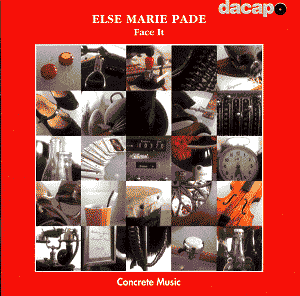Else Marie Pade became a student at the Royal Danish Conservatory
of Music in 1946 studying piano. She completed her studies but she felt
the need to explore an ‘internal universe of sound’ which she had been
hearing internally since childhood. She began taking private composition
lessons with Vagn Holmboe, Jan Jaegaard and Leif Kayser. When she discovered
Musique Concrète in 1952 during a Danish Radio broadcast about
Pierre Schaeffer she immediately set off to Paris to visit the composer.
Danish engineer Holger Lauridsen and Werner Meyer-Eppler in Cologne, Germany,
helped her to find her own style using electronically generated sounds
merged with natural sounds. Established Danish composer Knudage Riisager
attacked her works in print, and she felt there was a dimension of gender
intolerance in the generally negative reaction her works aroused. Nevertheless
she continued to compose until the mid-1960s when her increasing responsibilities
as producer required all her resources.
The Symphonie Magnétophonique is at once
gripping, exciting, and the unfolding of it is a constant delight. Each
moment is informed by a skilled, sophisticated musical instinct, and
it deserves to be honoured, along with Pierre Henry’s Voile d’Orphée,
Edgard Varèse’s Poème Electronique, and David Talcott’s
Trilogy as a great classic of the Musique Concrète repertoire.
Unfortunately, the other pieces on this disk lose their
impact for a non-Danish speaker. I found the 43 minute recitation of
"The Little Mermaid" in Danish more than I could take, however
ingenious the sonic background might be. Face It is a cute idea
for a one minute piece, but after you’ve heard ‘Hitler Is not Dead’
repeated in Danish 200 times (more or less) accompanied by the steady
beat of a drum, eight minutes feels like 80. But, no matter, one masterpiece
per CD is enough of a bargain.
Translating Musique Concrète into German as
konkrete Musik may be OK, but "Concrete Music" sounds
perfectly silly in English, as do most other attempts at a translation.
Apparently the correct and agreed-upon English term is ‘Musique Concrète’,
not by any means the only case where French words have entered into
English without change. Also the program notes suggest that Musique
Concrète began in the 1950s on the tape recorder with Pierre
Schaeffer, but in fact several people were doing it decades previously
using disk recorders. Electronic musical instruments date from the 1920s.
By 1926 microphones had reached a high state of development, and the
idea of recording natural sounds must have occurred to many at the time.
Paul Shoemaker
